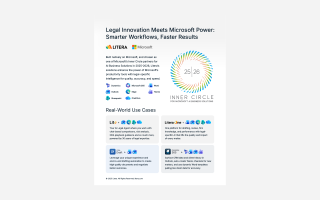What’s Driving Change in the Legal Industry? Market Trends Session at the Changing Lawyer Virtual Summit
George Rudoy jokingly refers to his job as “marriage counseling.” In his practice as Partner and Firmwide Leader of Legal Management Consulting and eDiscovery at Crowe, he is often right in the middle of relationships between in-house corporate legal departments and the law firms that serve them. Like a marriage, those relationships face evolving expectations and needs for both parties. Sometimes the two sides need some help to navigate forward. Providing that help gives Rudoy lots of insight into the dynamics of the industry today.
Rudoy was interviewed by Sherry Kappel, Technology Evangelist, Change Champion, and Innovator at Litera.
Firms and in-house – a shifting balance of power
One of the primary drivers of change in the legal industry is the increased pressure on legal departments to align more closely with company strategy, said Rudoy. Law departments used to be autonomous and less accountable for costs and efficiencies. But as those costs have risen, “management has started to ask more questions’” said Rudoy. “What can you do to leverage technology? How are you managing insourcing and outsourcing?” The result is a sharpened focus on streamlining legal operations tools and methods, including technology.
But like a good marriage counselor, Rudoy finds himself serving both sides. “We actually get hired by both parties. Sometimes the C-Suite in a company hires us to have a look at their legal function, sometimes the GC will come to us in response to new demands from above. But law firms are engaging with us as well; sometimes they need help responding to an RFP or RFI.” Law firms see the changes their clients are going through, and need to be responsive to those plans as well.
That’s where the marriage counseling comes in.
“As relationships change, and standards and requirements change, a lot can get lost in translation between firms and clients,” said Rudoy. “A good example is dashboards and exchange of information. So imagine a corporate law department that determines that it wants to outsource, and they have technology that we help them implement. Law firms need to be in line with that.” The key is that it “all needs to be operated consistently, and sometimes they need a third party to ensure that it all works, in terms of processes and protocols.”
Trends – Law Firms Face a War for Talent and Expansion Challenges
Rudoy illustrated some current tensions in law firm practice by highlighting a memo that Morgan Stanley sent out to its outside law firms last year, during a lull between waves of the pandemic. Morgan Stanley’s memo said, essentially, “if you want to work for us, be sure your associates are in the office.” Rudoy said that the memo was a bit of a bombshell in the industry. He understands the preference clients might have for their outside lawyers working from an office, but “the timing was off,” said Rudoy. It created quite a splash in the industry and clients asked Crowe to get involved. The problem, said Rudoy, is that associates are absolutely in high demand right now. This puts firms in a bind when associates are saying “we have options” and “we will move if we have these kinds of requirements.” That talent crunch is driving so many decisions in today’s market, and associates are often in the driver’s seat.
Rudoy sees firms taking one of two directions with regard to how they are evolving. Some are getting bigger and bigger, operating in more markets – Dentons is an example. As they get bigger, they need protocols, procedures and technology just to keep operating. Then there are other outliers who are becoming fully virtual. They are relying less on that centralization of resources, but they too need to focus on processes that allow them to function.
Trends: In-house Meeting Demands with a New Generation of Lawyers
On the Corporate side, Rudoy said that legal trends continue to be around doing more with less, implementation of technology, process and protocols. Again, these things aren’t new, but pressure is escalating. There’s a need for more predictable processes and budgets for legal departments. The big trend, he said, is that lawyers are starting to take this seriously, and not just thinking those demands will go away in the next cycle.
An additional factor playing into that trend, as on the law firm side, is the behavior of younger lawyers. They are no longer necessarily starting their careers in a firm before shifting to in-house after a number of years. An increasing number go directly to corporations. It’s a sign of the times – many are attracted to the corporate world and it’s almost a lifestyle choice.
“That change helps corporate legal departments respond to the demands,” said Rudoy. “They can find people who are more technologically inclined. They get someone who is much more adaptable to in-house practice because there is not that pre-set mentality that you have to start in a firm.”
Trend: Cloud Expectations Changing
How has the pandemic affected the shift from on-premise software to cloud solutions?
“Technology in general is moving to the cloud. Attorneys are less and less concerned about potential exposure of data, given that it has been proven and been around for a while; in fact many see now that the cloud is more secure than what they might have on-premise installations,” said Rudoy. He added that the cloud solves a lot of the issues around remote work. It has removed an obstacle to remote work. Home offices can have a standard connection to firm systems, and firms can implement new protocols that are just as secure as in-office systems. “Whether you are working from home or from the office, the environment is exactly the same.”
“So from the technology perspective, it’s not an issue. But from the collaboration, spending time together perspective – that’s another conversation. But from a tech perspective, the cloud has really enabled remote work.”




